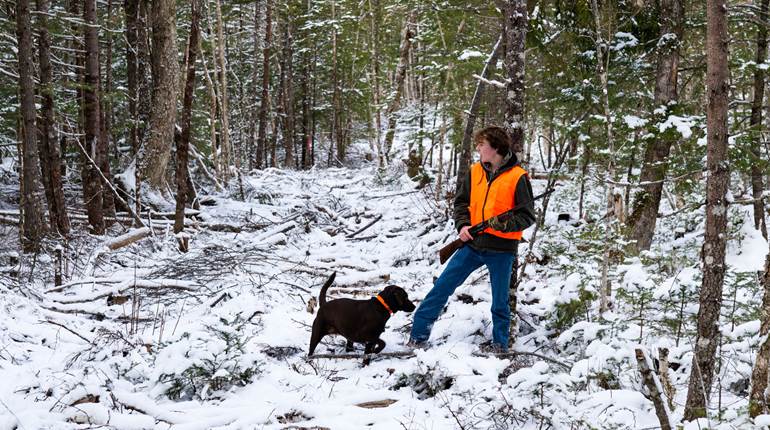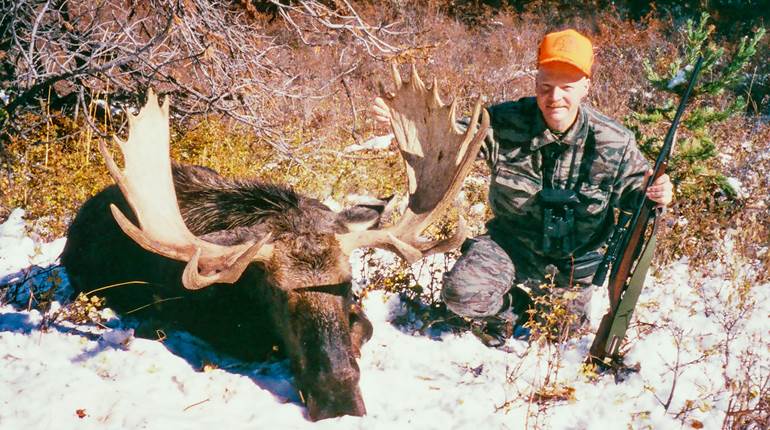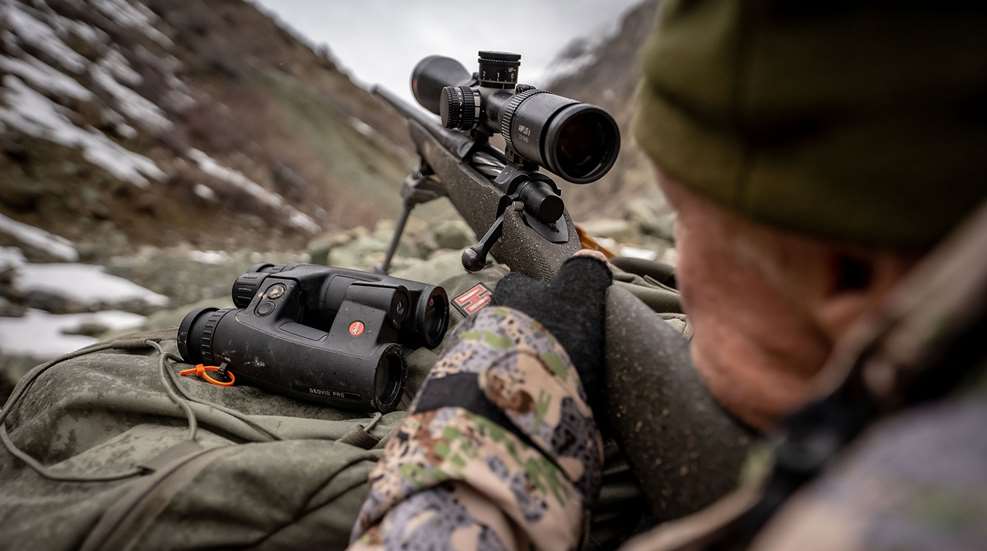
The old adage for hunters was “get as close as you can, then get 10 yards closer.” That's still valid, despite today’s fascination with long-range shooting. Equally valid, and perhaps more important: “Get as steady as you can.”
To a large degree, it’s stability, not distance, that dictates the practicality of an accurate shot. In field shooting, the ethics. If you aren’t steady enough to be certain, don't take the shot. There are lots of ways to acquire an adequately stable shooting position and, in most situations, multiple options. Sometimes, one of the four NRA shooting positions (prone, sitting, kneeling, standing) fill the bill perfectly. Other times, a handy rock or tree fills the bill nicely.
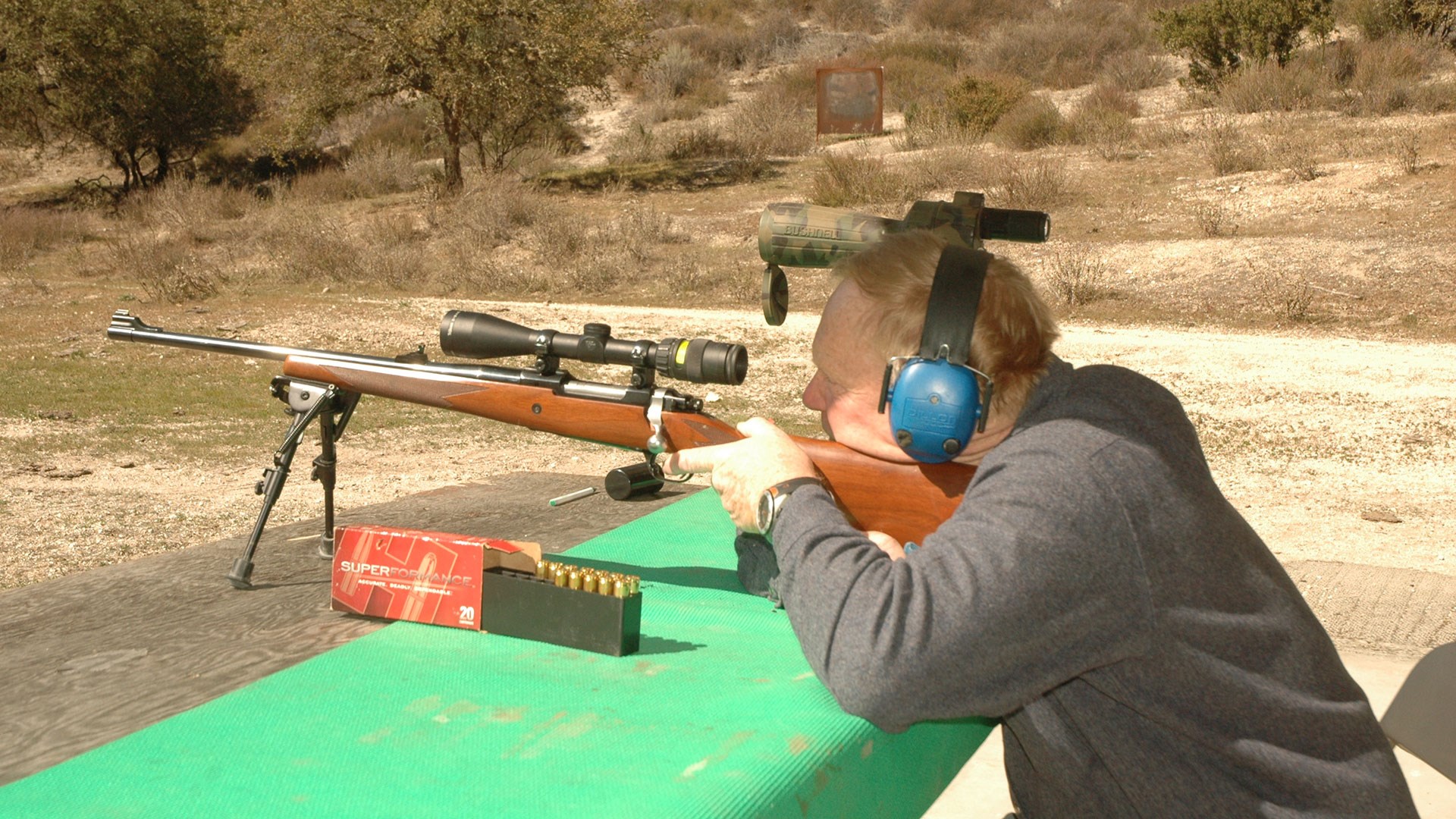 A sturdy bipod is almost as steady as over sandbags on a bench. This is a Harris bipod, long the gold standard. While a great bipod, it’s not light, and attaching takes a bit of time.
A sturdy bipod is almost as steady as over sandbags on a bench. This is a Harris bipod, long the gold standard. While a great bipod, it’s not light, and attaching takes a bit of time.
Given a choice, I’m mostly a “pack-over-a-rock” guy. Sometimes, that choice doesn’t exist so, like many of us, much of the time I carry a shooting aid, something extra to add stability. Here are three systems worth considering.
African Shooting Sticks
In Africa, this is how it works: the tracker, with the best eyes, leads, carrying shooting sticks, a simple tripod, legs joined at the top. The professional hunter (PH) follows closely, with you third in line. When the tracker nears an opening, he spots a three-toed "gazork" on the far side. He then sets up the sticks and steps to the left. The PH raises binoculars, nods and whispers, “Sir, that’s a jolly fine 'gazork.' I think you must take him.” He steps to the right; it’s your job to step forward, rest your rifle over the intersection of the sticks and take the shot.
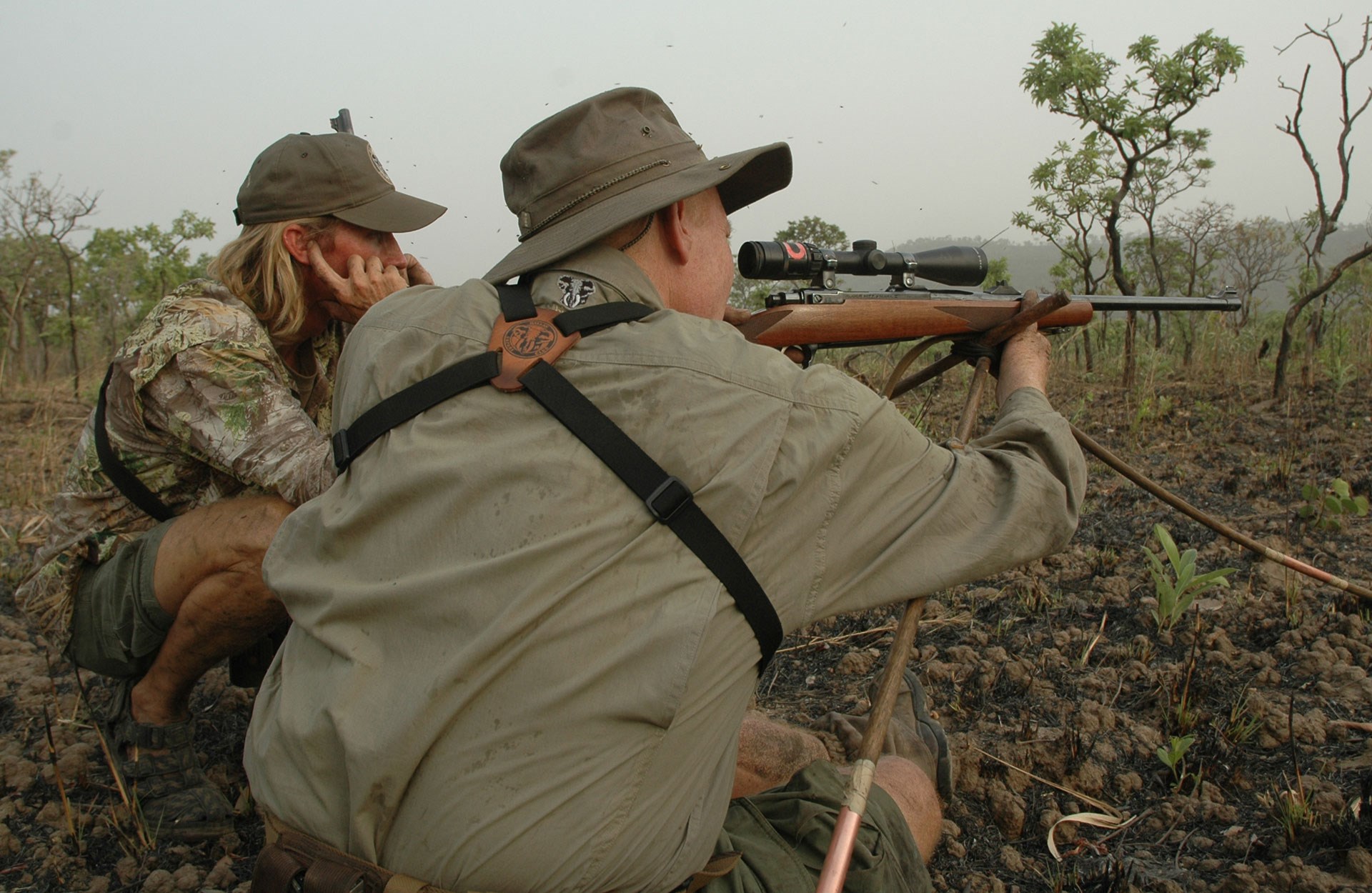 Traditional three-legged shooting sticks can be spread wide for use in a low position. Boddington took a Lord Derby’s giant eland from this position in northern Cameroon, his most prized African animal.
Traditional three-legged shooting sticks can be spread wide for use in a low position. Boddington took a Lord Derby’s giant eland from this position in northern Cameroon, his most prized African animal.
Over there, brush and nasty thorns often preclude a low position or natural rest. Standing against a tall tripod gets you above low vegetation and provides fast, quiet stability for short- to medium-range shots, maybe 150 yards. This is adequate in much mixed cover.
Sticks alone are not stable enough for shooting at distance. For longer shots, there is often time to figure a better solution. However, with practice, confidence and steadiness with sticks improves rapidly. I first hunted Africa 40-some years ago. I’d never heard of shooting sticks; the first time I saw such a contraption was when we checked zero. Don’t do this to yourself! If considering an African hunt, get a set of shooting sticks, and practice with them.
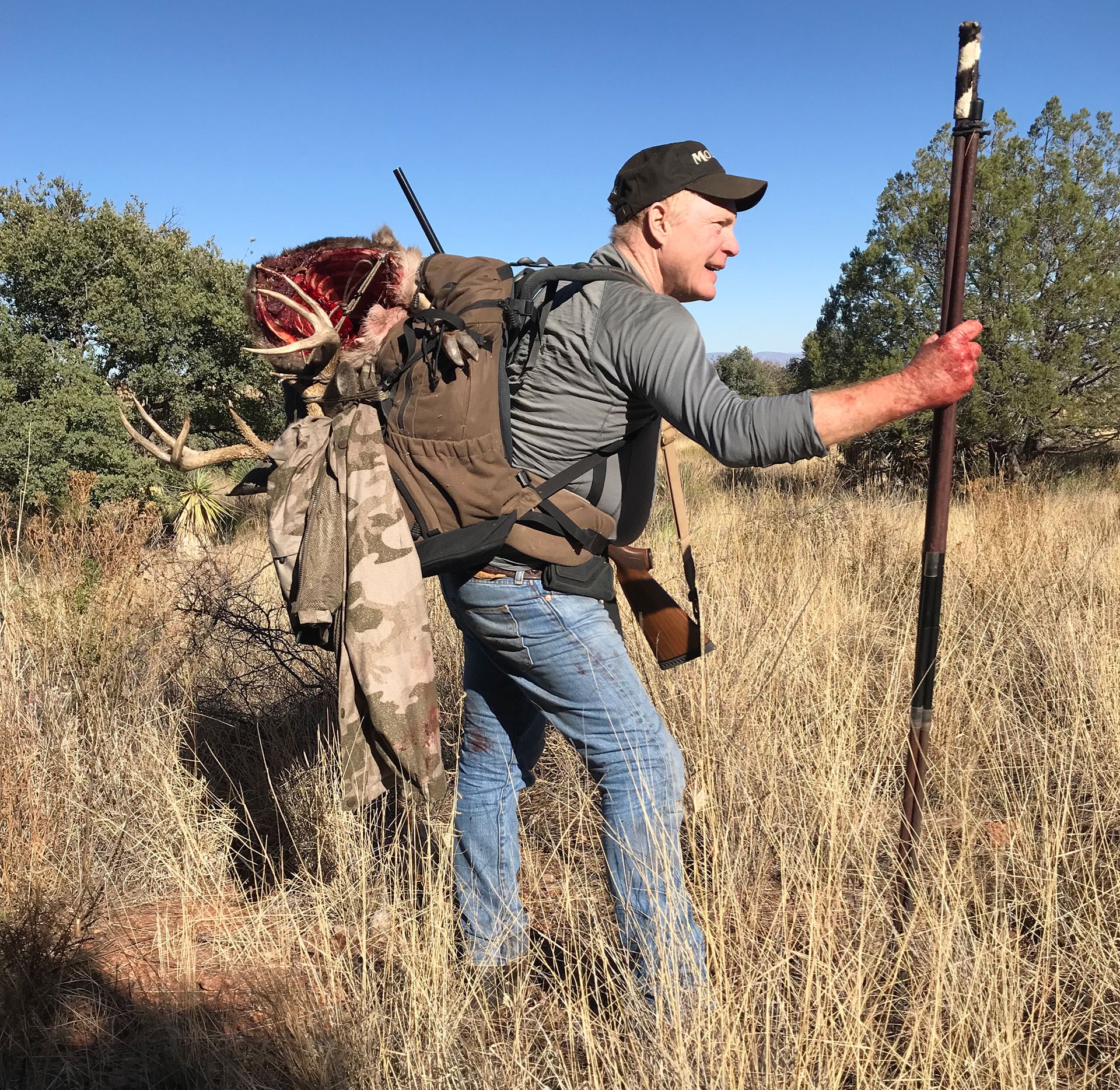 Boddington takes his African shooting sticks almost everywhere. With the bottom of the legs secured with an elastic band, they make a good hiking staff and are there as a shooting aid, when needed.
Boddington takes his African shooting sticks almost everywhere. With the bottom of the legs secured with an elastic band, they make a good hiking staff and are there as a shooting aid, when needed.
Even if Africa is of no interest, shooting sticks are useful in many situations. With the bottom of the legs secured with an elastic band, they double as a hiking staff, so I take them almost everywhere, and I do at least some shooting from them almost every time I go to the range. You can easily make your own, but the sticks I’ve been using for years are from African Sporting Creations, available in several models in oak, hickory, exotic wood and carbon fiber. Almost any set of sticks can be spread wide and used for lower shooting positions. However, the ones I use are the Dark Continent Shooting Sticks with two-section legs with aircraft aluminum joints. I break them down for travel and put them in my gun case and, with a section removed, I use them as a lower tripod, perfect for sitting or kneeling behind.
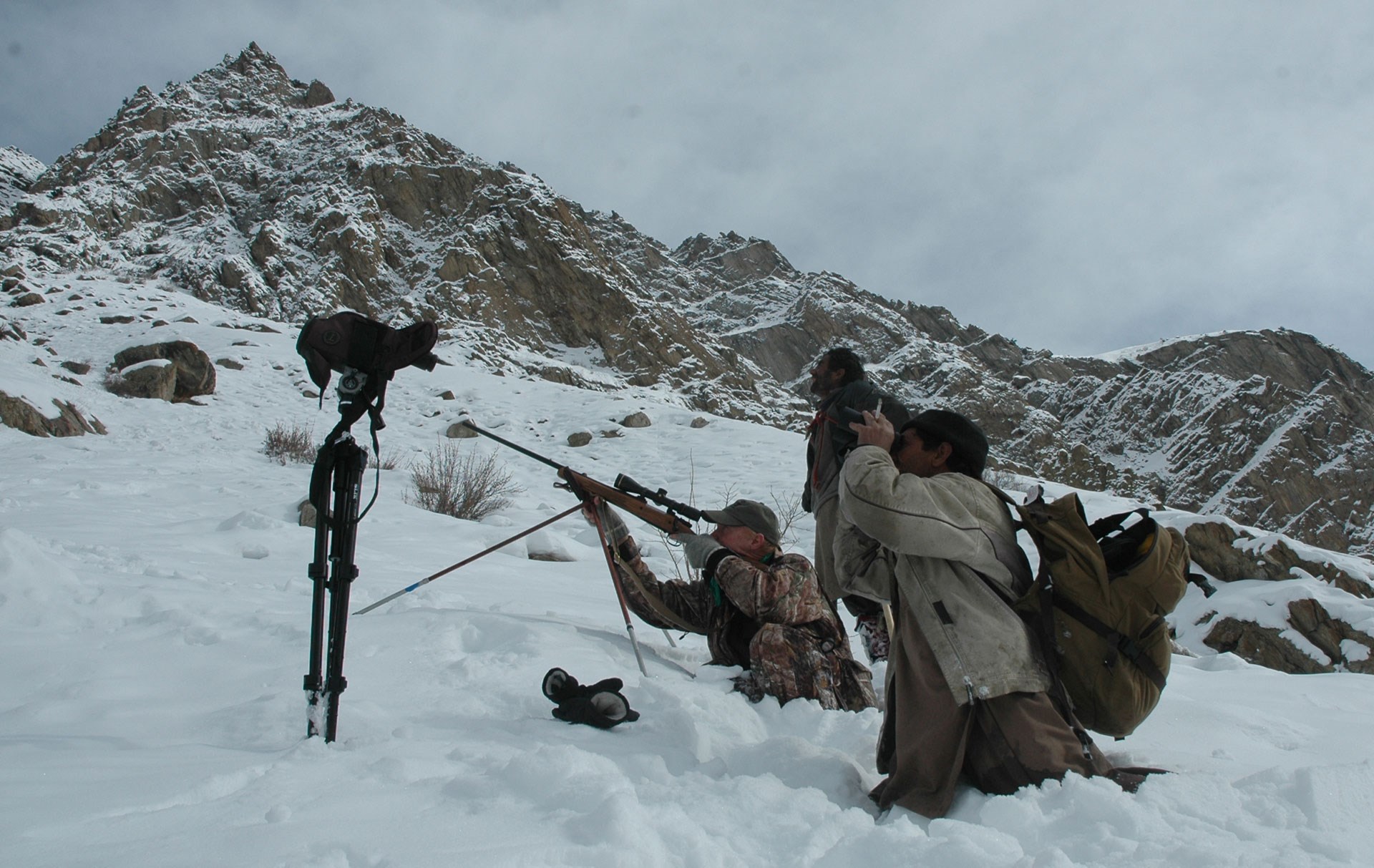 Boddington has hauled his African shooting sticks all over the world. Here, he’s taking a tough uphill shot in deep snow in northern Pakistan, shooting a Himalayan ibex far up in the cliffs.
Boddington has hauled his African shooting sticks all over the world. Here, he’s taking a tough uphill shot in deep snow in northern Pakistan, shooting a Himalayan ibex far up in the cliffs.
Correct height is critical, in two ways: First, the sticks need to be long enough to accommodate your height, but not too long. I’m Joe Average 5’ 9”. My sticks are size large at 70", which ASC’s Jim Morando says are ideal for people from 68" to 73" in height. Next, it’s essential for the sticks to be set up at the right height for you. With tripod legs spread, I like the juncture of the sticks to be level with the top of my sternum. That way, I can lean slightly forward into the sticks. Position of the supporting hand is also critical. There’s no right or wrong way, but I like to hold the fore-end with thumb and forefinger, grasping the sticks with my other three fingers and tying everything together.
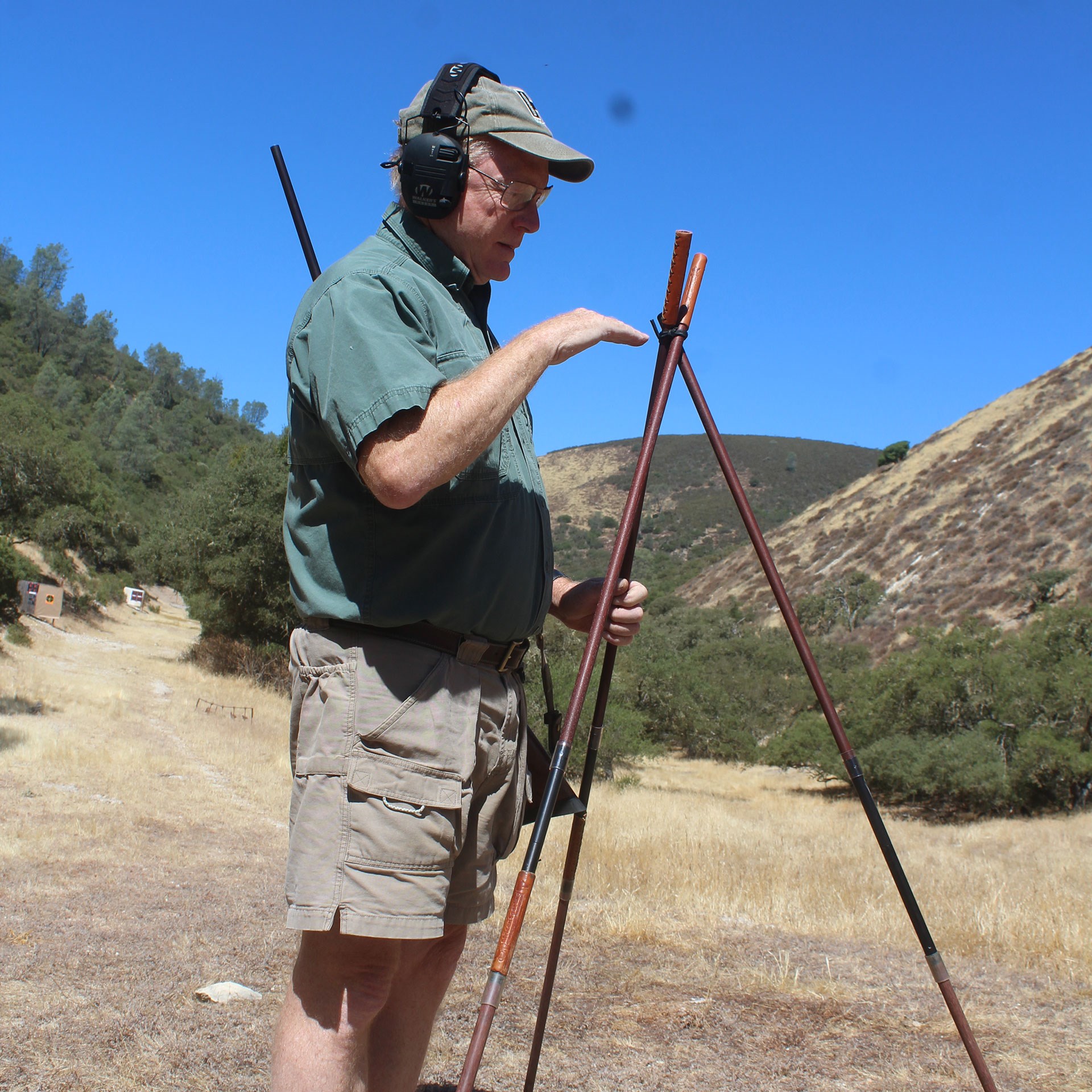 Proper set-up height is probably the most important factor with shooting sticks. Boddington likes the juncture of the sticks about level with his first shirt button or top of the sternum, allowing him to lean slightly into the sticks to gain isometric support.
Proper set-up height is probably the most important factor with shooting sticks. Boddington likes the juncture of the sticks about level with his first shirt button or top of the sternum, allowing him to lean slightly into the sticks to gain isometric support.
4STABLESTICKS
With regular practice—painlessly and cheaply done with a .22 LR rifle—confidence and accuracy will improve, along with effective range off sticks. My wife, Donna, is steadier off sticks than I am and can shoot farther. However, most shooters retain a slight wobble with sticks, limiting shooting distances. There are multiple modern systems that reduce (or potentially eliminate) that wobble. All are a bit more complicated and take a few seconds more to employ than good old sticks but, with greater stability, extend effective range. The one that I like the best is 4StableSticks.
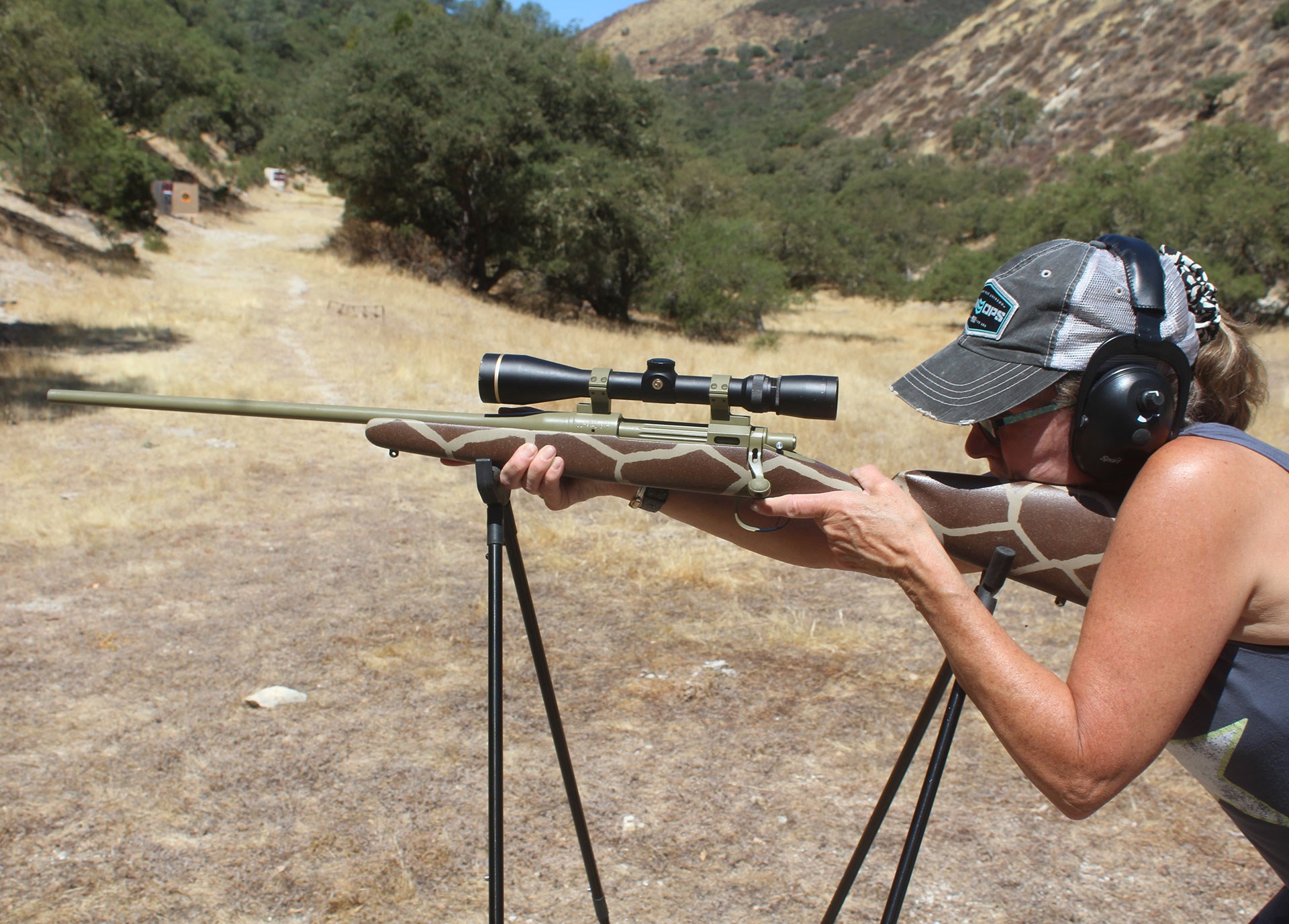 Donna Boddington on the range with 4StableSticks. Brilliant off simple three-legged shooting sticks, she didn’t like them at first, but with practice agreed that their stability was amazing.
Donna Boddington on the range with 4StableSticks. Brilliant off simple three-legged shooting sticks, she didn’t like them at first, but with practice agreed that their stability was amazing.
Made in France, 4StableSticks is exactly that: two pairs of sticks, front and rear both joined at the bottom so they spread outward in inverted. The front legs support the fore-end; the rear pair supports the rifle butt. Available in carbon fiber or aircraft aluminum, the legs are jointed for travel, the whole system weighing just 15 ozs. The height is adjustable from 28.5" to 42", practical for shooters from 5’5” to over 6'.
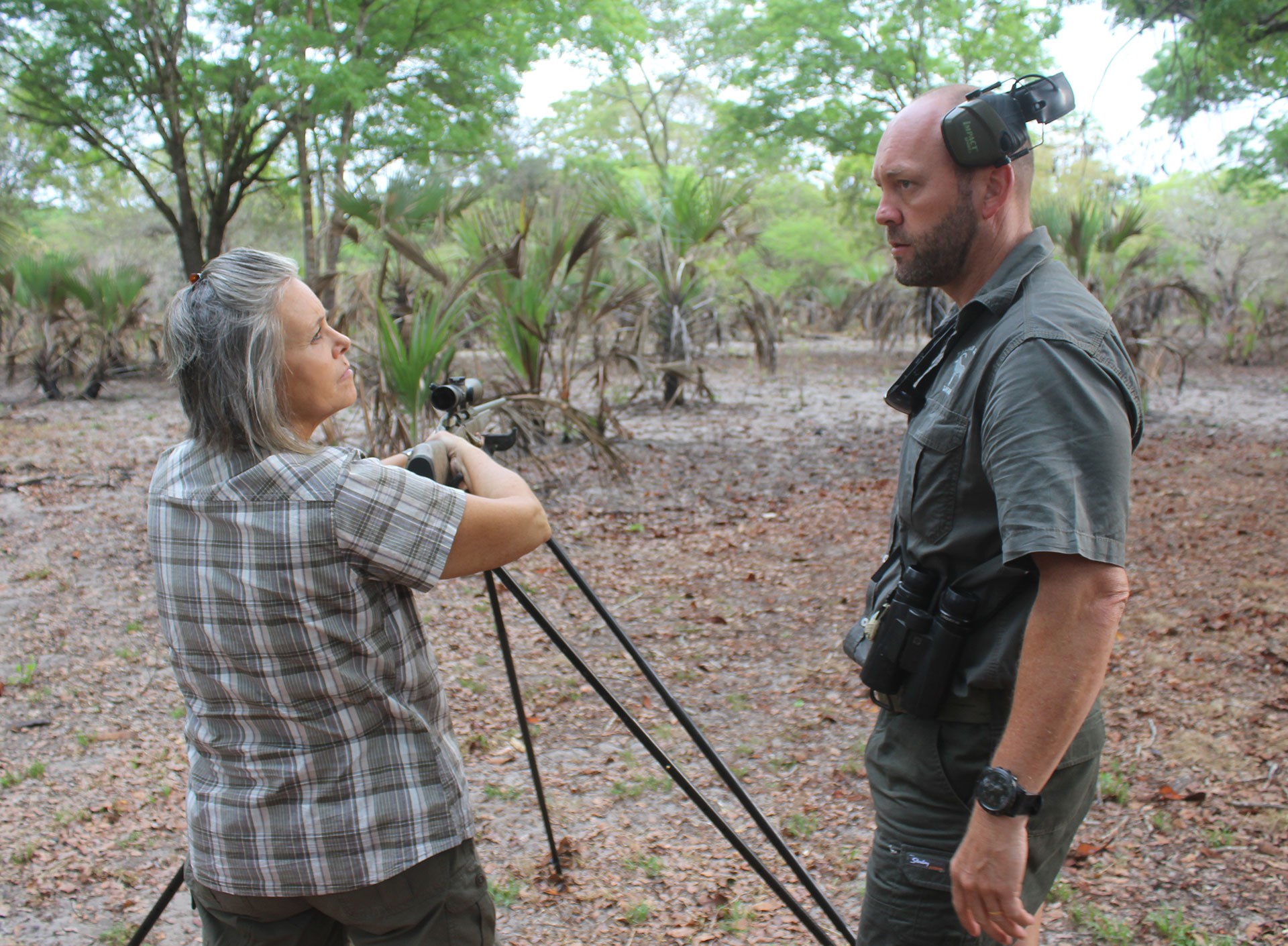 Mozambique PH Ben Rautenbach demonstrates the 4StableSticks system to client Melissa Belcher. Although incredibly stable, all unfamiliar shooting aids require practice.
Mozambique PH Ben Rautenbach demonstrates the 4StableSticks system to client Melissa Belcher. Although incredibly stable, all unfamiliar shooting aids require practice.
Here's the beauty: The front and rear pairs are joined at the top by rubber rests. The front rest, as you might expect, is a V. The rear rest is a flat, ribbed panel, providing a nonslip surface to grip the buttstock, but also allowing significant side-to-side motion if an animal takes a few steps—without needing to reset the sticks.
4StableSticks requires some getting used to but, once you get the hang of it, stability approaches benchrest. I’ve used it for hunting big game, but I’ve also used it for prairie-dog shooting, tiny targets that require absolute steadiness. Shooting distances with 4StableSticks depend entirely on the shooter’s ability which, as always, comes down to confidence acquired through practice.
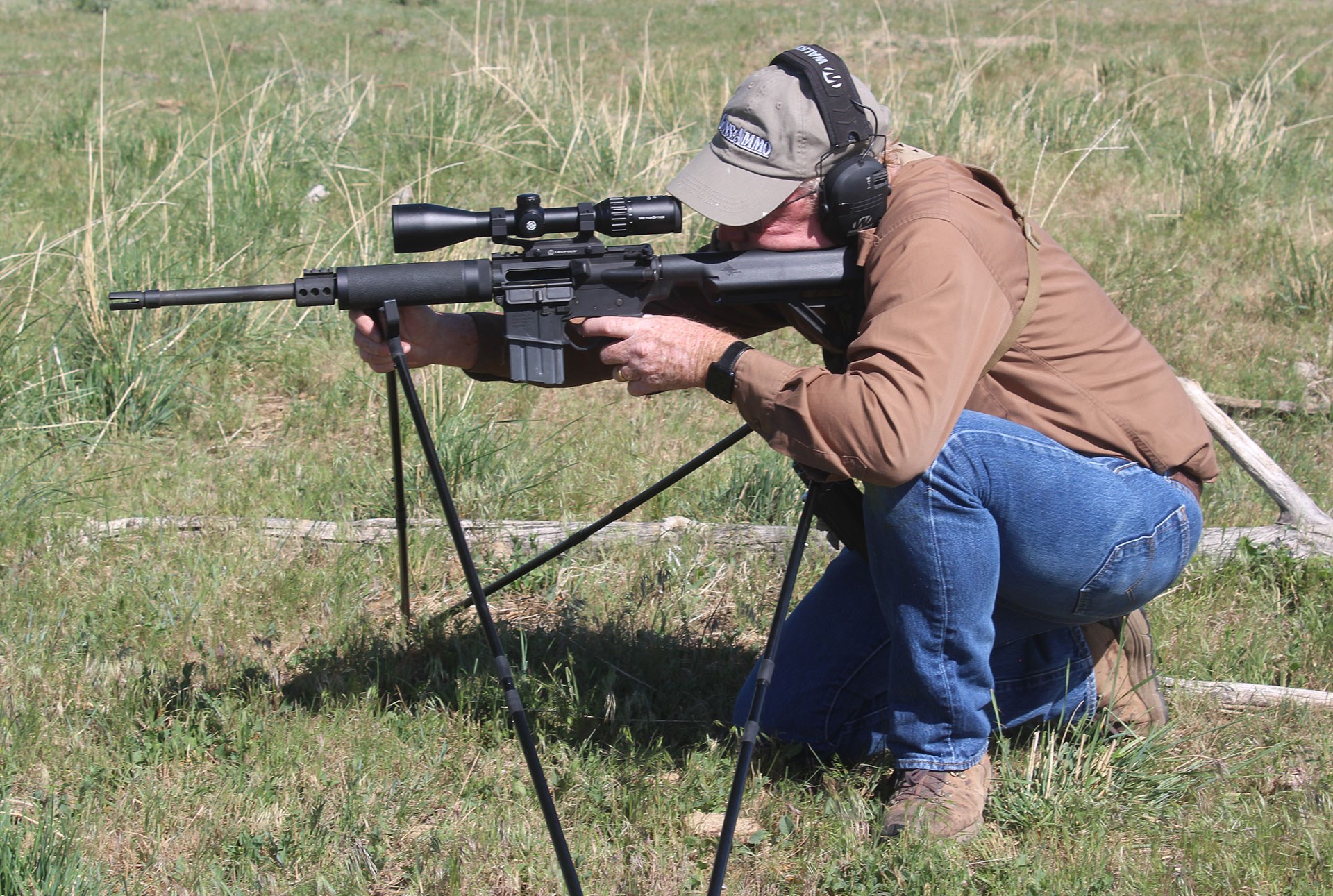 Prairie-dog shooting is marvelous practice for field shooting. Boddington tried 4StableSticks in a prairie-dog town and found the stability amazing.
Prairie-dog shooting is marvelous practice for field shooting. Boddington tried 4StableSticks in a prairie-dog town and found the stability amazing.
JAVELIN BIPOD SYSTEM
Bipods have long been popular among American shooters and hunters. Today, with the popularity of long-range rifle shooting, the stability of a bipod is wonderful. Bipods from Harris Engineering are the benchmark; I’ve used them in open country for nearly 40 years. Typically, they attach to the front sling swivel stud with a pin. Doesn’t take long, but you’re probably not going to attach, detach or reattach in the field.
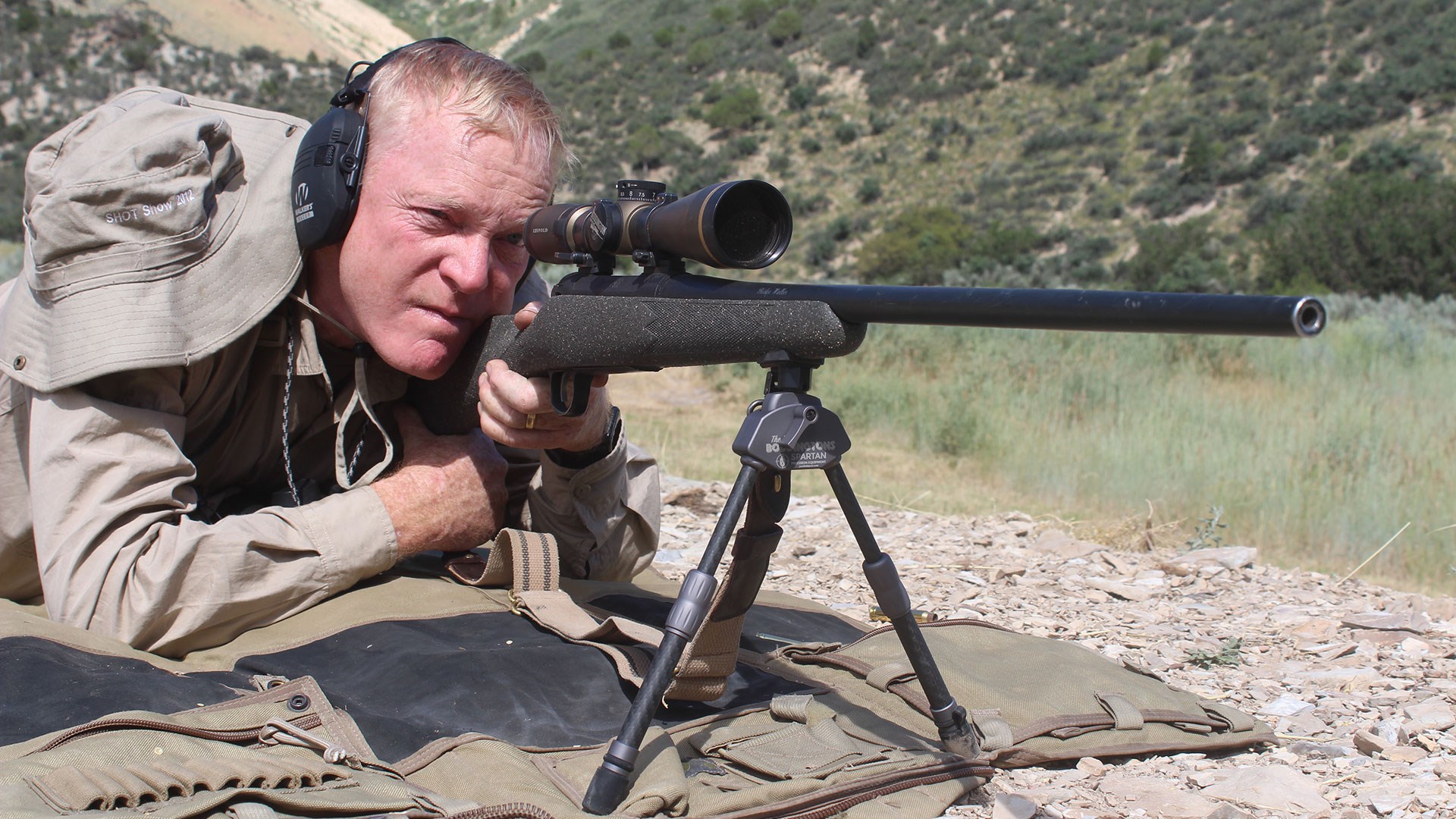 The Javelin Pro Hunter bipod, made from strong, light carbon fiber, has extending legs and weighs just 6.3 ozs.
The Javelin Pro Hunter bipod, made from strong, light carbon fiber, has extending legs and weighs just 6.3 ozs.
Several years ago, I discovered the Javelin bipod from Spartan Precision Equipment. Made from light, strong carbon fiber, the company's Pro Hunt with adjustable legs weighs just 6.3 ozs. For me, the real selling point: Javelin attaches with a strong magnet, contained in a fixture that slips over the front sling swivel stud or attaches to a forward rail strip (also incorporating sling attachment). The magnetic attachment absolutely works! I can carry the bipod in a belt pouch or in a side pocket of my pack. Out of the way and adding no weight to the rifle until needed, then snaps into place instantly.
I started with the basic Javelin bipod, but it’s grown into a system, all the way up to a full-size Ascent tripod with larger-diameter telescoping legs. With Davros head, it clamps to the rifle with the same magnetic attachment, suitable for sitting to standing. Or, with attachments, it provides a stable platform for spotting scope or camera.
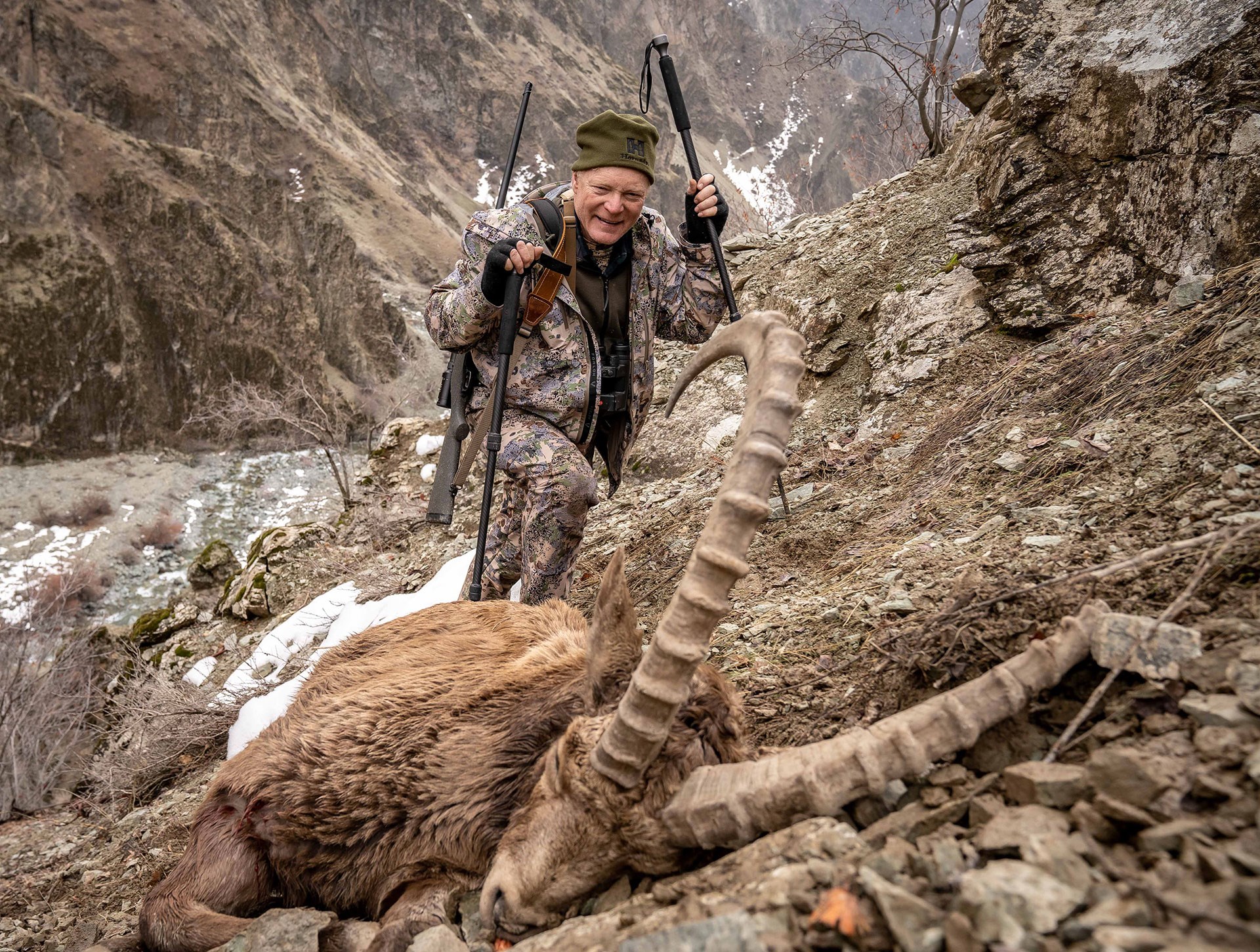 In Tajikistan, in February 2022, Boddington believes the Javelin bipod saved the day. With a tough uphill shot, the bipod was essential to gain the height needed for a supported position. He took it out of his pack, popped it onto the rifle and made the shot.
In Tajikistan, in February 2022, Boddington believes the Javelin bipod saved the day. With a tough uphill shot, the bipod was essential to gain the height needed for a supported position. He took it out of his pack, popped it onto the rifle and made the shot.
We all develop comfort zones. In Africa, I’m pretty much a three-legged shooting sticks guy; for mountain hunting, I’m most likely to flop my pack down on a handy rock. But it’s a mistake to get fixated on one method, and even old dogs like me can learn new tricks. The beauty of the Javelin bipod: You don’t have to use it, but it’s almost weightless and there, if you want it. In Tajikistan last February, I drew a tough uphill shot at my ibex. Had the rock and had my pack, but I couldn’t get the angle right. I reached into the side pocket for the Javelin, extended the legs, and made a quartering-to shot with absolute confidence.












